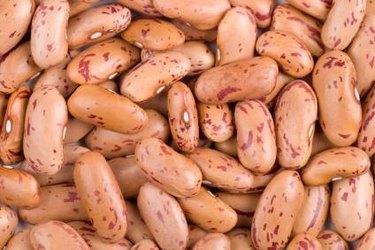
Served with rice and in Mexican cuisine, pinto beans are a member of the kidney bean family. This legume is an excellent source of cholesterol-lowering fiber. Available year-round and purchased dried, canned, mashed and refried or in bulk, pinto beans have an earthy flavor and solid texture. Enjoy pinto beans in chili, soups and stews. Blend beans with seasonings as a dip or serve alongside Mexican rice and enchiladas or tacos.
Geography
Video of the Day
Originally, pinto beans were cultivated in Central and South America. The beans made their way to Mexico and across the United States. Manufacturers and suppliers are also in Australia, Brazil, Canada, China, Ethiopia, India, South Africa, Spain and the United Kingdom.
Video of the Day
Types
Varieties of pinto beans include Álava, Burke, Buster, Grand Mesa, Kodiak, Maverick, Othello and Sierra.
Identification
Medium-sized and oval in shape, pinto beans can be recognized by their reddish speckles atop a beige background. When cooked, all the spotting disappears to leave behind a pinkish bean.
Benefits
Combined with rice, pinto beans provide a complete protein. The beans are a good source of thiamine and pyridoxine, both B vitamins. They also contain essential minerals such as iron, magnesium, potassium and selenium.
Considerations
When purchasing in bulk, make certain that the bin is covered. Look for whole beans that have not been cracked or damaged. When purchasing canned pinto beans, ensure they do not contain additives and salt for an equally healthy option.
Fun Facts
"Chile and frijol" (pepper and pinto bean) was adopted in 1965 by New Mexico as the official state vegetable. Dove Creek, Colorado, is renowned as the "Pinto Bean Capital of the World."